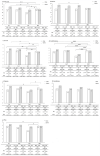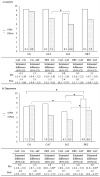Distinct Protocols of Physical Exercise May Improve Different Aspects of Well-being in Women With Polycystic Ovary Syndrome
- PMID: 36636404
- PMCID: PMC9830240
- DOI: 10.1177/15598276211001330
Distinct Protocols of Physical Exercise May Improve Different Aspects of Well-being in Women With Polycystic Ovary Syndrome
Abstract
The purpose of this study to assess the effects of different protocols of physical exercise on the domains of the quality of life (QoL), sexual function, anxiety, and depression scores in women with polycystic ovary syndrome (PCOS). Data of 112 women with PCOS were extracted from 2 trials with different protocols of physical exercise: continuous aerobic training (ContinuousAT, n = 23), intermittent aerobic training (IntermittentAT, n = 22), and progressive resistance training (ResistanceT, n = 43) alongside a control group (CG, n = 24). Volunteers who completed self-report questionnaires-Female Sexual Function Index (FSFI), the Hospital Anxiety and Depression Scale (HADS), and the MOS 36-Item Short-Form Health Survey (SF-36) for QoL-preprotocol and postprotocol of physical exercise were included. Within groups, from baseline to week 16, all ContinuousAT, IntermittentAT, and ResistanceT protocols promoted improvements in multiple FSFI domains and HADS scores. However, ResistanceT did not improve the QoL aspects. Between groups, from other physical training protocols, the IntermittentAT was most effective for QoL and FSFI domains as well as HADS scores. It is concluded that all interventions were effective and improved indicators of sexual function, anxiety, and depression. When comparing protocols, interval training with high-intensity stimuli and active recovery was more effective.
Keywords: anxiety; depression; physical exercise; polycystic ovary syndrome; quality of life; sexual function.
© 2021 The Author(s).
Conflict of interest statement
The author(s) declared no potential conflicts of interest with respect to the research, authorship, and/or publication of this article.
Figures


Similar articles
-
Comparison of the Effect of Intermittent and Continuous Aerobic Physical Training on Sexual Function of Women With Polycystic Ovary Syndrome: Randomized Controlled Trial.J Sex Med. 2018 Nov;15(11):1609-1619. doi: 10.1016/j.jsxm.2018.09.002. Epub 2018 Oct 11. J Sex Med. 2018. PMID: 30316737 Clinical Trial.
-
The effects of aerobic physical exercises on body image among women with polycystic ovary syndrome.J Affect Disord. 2020 Feb 1;262:350-358. doi: 10.1016/j.jad.2019.11.025. Epub 2019 Nov 9. J Affect Disord. 2020. PMID: 31735408 Clinical Trial.
-
Impact of Physical Resistance Training on the Sexual Function of Women with Polycystic Ovary Syndrome.J Sex Med. 2015 Jul;12(7):1584-90. doi: 10.1111/jsm.12909. Epub 2015 May 18. J Sex Med. 2015. PMID: 25982537
-
Effectiveness of exercise interventions on mental health and health-related quality of life in women with polycystic ovary syndrome: a systematic review.BMC Public Health. 2021 Dec 20;21(1):2310. doi: 10.1186/s12889-021-12280-9. BMC Public Health. 2021. PMID: 34930180 Free PMC article.
-
Conservative treatment options for polycystic ovary syndrome: the importance of exercise.Ceska Gynekol. 2020 Winter;85(6):430-435. Ceska Gynekol. 2020. PMID: 33711904 Review. English.
Cited by
-
Bridging the Gap: Integrating Awareness of Polycystic Ovary Syndrome Into Mental Health Practice.Focus (Am Psychiatr Publ). 2024 Jan;22(1):53-62. doi: 10.1176/appi.focus.20230024. Epub 2024 Jan 12. Focus (Am Psychiatr Publ). 2024. PMID: 38694159 Free PMC article. Review.
-
Resistance and aerobic training increases genome-wide DNA methylation in women with polycystic ovary syndrome.Epigenetics. 2024 Dec;19(1):2305082. doi: 10.1080/15592294.2024.2305082. Epub 2024 Jan 21. Epigenetics. 2024. PMID: 38245873 Free PMC article.
-
Mediating role of anxiety between body image distress and quality of life among women with polycystic ovary syndrome: a multicentre cross-sectional study.BMC Womens Health. 2024 Dec 21;24(1):658. doi: 10.1186/s12905-024-03490-5. BMC Womens Health. 2024. PMID: 39709416 Free PMC article.
References
LinkOut - more resources
Full Text Sources
